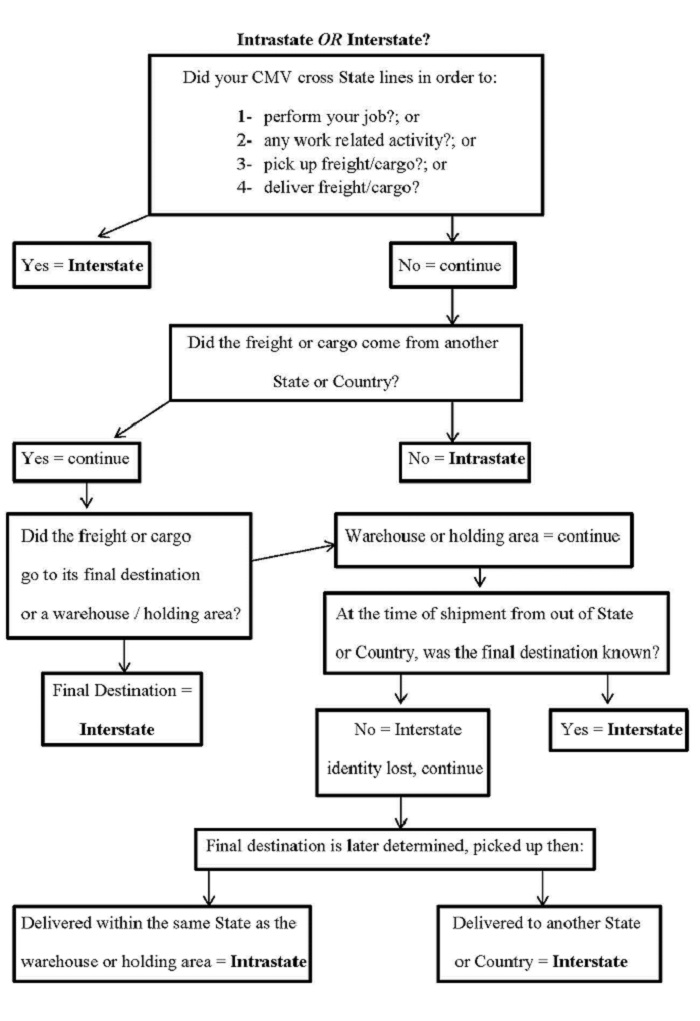
Intrastate Commerce vs. Interstate Commerce
Interstate Commerce is defined by the Federal Motor Carrier Safety Regulations as trade, traffic, or transportation in the United States –
1- Between a place in a State and a place outside of such State (including a place outside of the United States); or
2- Between two places in a State through another State or place outside of the United States; or
3- Between two places in a State as part of trade, traffic, or transportation originating or terminating outside the State or the United States.
Intrastate Commerce is defined by the Federal Motor Carrier Safety Regulations as any trade, traffic, or transportation in any State which is not described in the term “interstate commerce”.
The following interpretations can be found in 49 CFR 390.3.
Question 2: Are the FMCSRs applicable to drivers and CMVs which transport tools, equipment, and supplies across State lines in a CMV?
Guidance: Yes, the FMCSRs are applicable to drivers and CMVs in interstate commerce which transport property. The property in this situation is the tools, equipment and supplies.
Question 6: How does one distinguish between intra- and interstate commerce for the purposes of applicability of the FMCSRs?
Guidance: Interstate commerce is determined by the essential character of the movement, manifested by the shipper’s fixed and persistent intent at the time of shipment, and is ascertained from all of the facts and circumstances surrounding the transportation. When the intent of the transportation being performed is interstate in nature, even when the route is within the boundaries of a single State, the driver and CMV are subject to the FMCSRs.
Question 13: A motor carrier dispatches an empty CMV from State A into adjoining State B in order to transport cargo or passengers between two points in State B, and then to return empty to State A. Does the transportation of cargo or passengers within State B constitute interstate commerce?
Guidance: Yes. The courts and the ICC developed a test that clarifies the legal status of intrastate portions of interstate trips. The character of the intrastate leg depends on the shipper’s fixed and persistent intent when the transportation began. The fixed and persistent intent in this case was to move property—the vehicle itself—across State lines and between two points in State B where it was used to haul cargo or passengers. The transportation within State B, therefore, constitutes interstate commerce. In some cases the motor carrier may be the shipper.
Determining the difference between intrastate and interstate commerce is not always as easy as it sounds. A few examples are provided below in order to help in understanding the difference.
- A California motor carrier hauls freight from San Diego, California to a warehouse in Tulsa, Oklahoma, that shipment is interstate commerce since both the CMV and the cargo crossed State lines.
- An Oklahoma motor carrier arrives at the Tulsa warehouse to pick up the California freight being held there. At the time of shipment from San Diego, the final destination was listed as another location within Tulsa and not the warehouse. The Oklahoma motor carrier then delivers it to its final destination in Tulsa. This is also considered interstate commerce. Even though the motor carrier’s CMV never left Oklahoma, the carrier was involved in the furtherance of the original interstate trip since the freight’s destination, which was known at the time of shipment, was not the warehouse.
- “Oklahoma Electronics”, an electronics store in Tulsa, OK, wants to fill their stockroom with computers. They place an order that ships from a manufacturer in Texas arriving at “Oklahoma Electronics” stockroom in Tulsa. The trip from Texas to Oklahoma is interstate commerce since the CMV and freight crossed State lines. Once the computers arrive at the stockroom in Oklahoma, they will lose their interstate identity since the final destination at the time of shipment was the stockroom.
- “Oklahoma Intel”, an Oklahoma business, wants to buy 100 computers from “Oklahoma Electronics”, who fills the order from the computers in their stockroom. An Oklahoma motor carrier arrives at the store, picking up the computers and delivering it to “Oklahoma Intel”. Since the computers lost their interstate identity, the trip from “Oklahoma Electronics” to “Oklahoma Intel” is intrastate commerce.
- “Oklahoma Intel” orders more computers than the “Oklahoma Electronics” had in stock. “Oklahoma Electronics” places an order for more computers from Texas. The computers arrive at the store stockroom and are held there. A week later, an Oklahoma motor carrier arrives at “Oklahoma Electronics”, picking up the computers and delivers them to “Oklahoma Intel”. Since the final destination was known to be “Oklahoma Intel” when the computers were ordered and shipped from Texas, the Oklahoma motor carrier is involved in interstate commerce.
- An Oklahoma motor carrier picks up freight from an Oklahoma City manufacturer and delivers the freight to its final destination in Stillwater, OK this is considered intrastate commerce.
- A customer in Norman, OK purchases new appliances for their house from a local home improvement store. The store has all the appliances in their stockroom except a refrigerator which will need to be shipped from their distribution center in Texas. A week later, a local delivery truck picks up all the appliances from the store and delivers it to the customer, never leaving Norman, OK. Since the refrigerator’s final destination was known to be the customer’s residence at the time it shipped from a distribution center in Texas, the local delivery truck is involved in interstate commerce.


